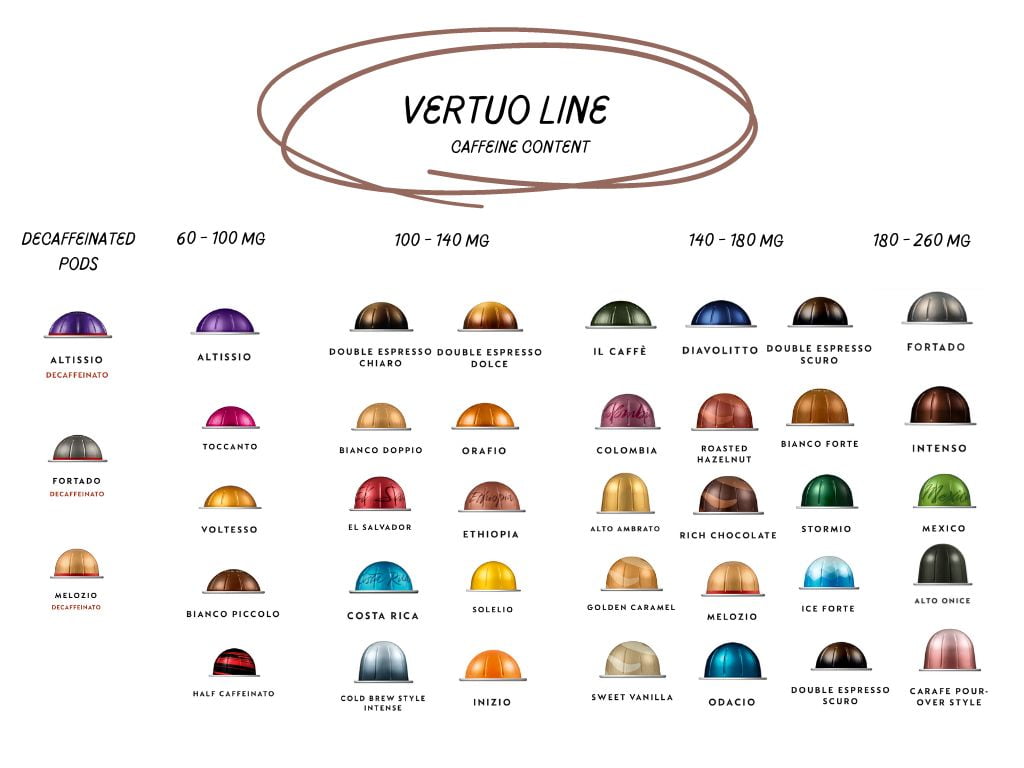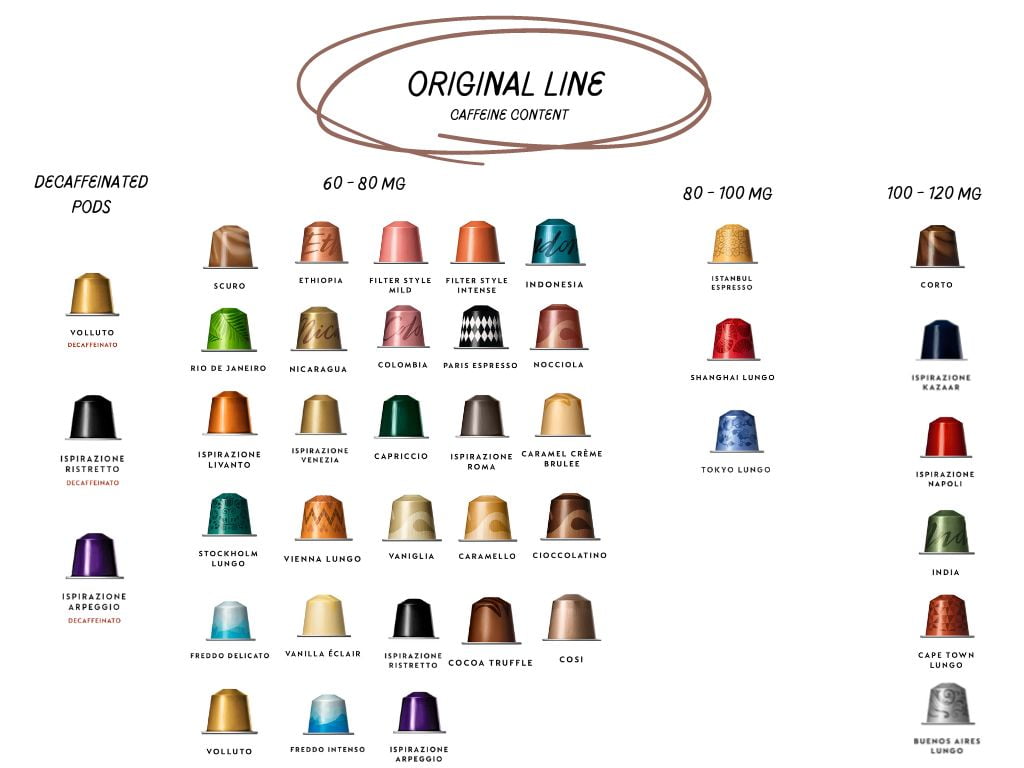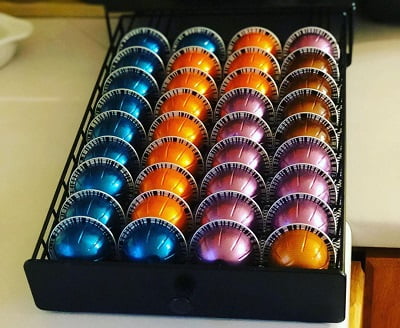Nespresso offers a wide range of coffee capsules with varying intensity and caffeine content.
I understand the importance of knowing the caffeine content in Nespresso pods as it allows us to select the right pod for our caffeine needs. That’s why I have compiled a detailed guide on Nespresso Caffeine Content.


Here’s an infographic for a quick overview of the Caffeine content of various Nespresso capsules. Simply save these charts on your phone and go through them whenever you need quick guidance.
As an Amazon Associate, I earn commission from qualifying purchases.
How much caffeine is in Nespresso Pods?
On average, Espresso-sized Nespresso capsules have about 60 to 80 mg of caffeine. Some Intense Coffee capsules can have over 100 mg of caffeine and the decaffeinated pod has only 1 to 5 mg of caffeine.
However, the caffeine content in Nespresso pods can vary depending on the type of beans and the size of the Capsules.
With around 40 different capsule varieties in the OriginalLine and 35 varieties in the VertuoLine, Nespresso offers a wide selection to cater to various tastes and caffeine preferences.
Nespresso does not mention the amount of caffeine in any capsule on the Nespresso USA website, I am not sure why.
On the Nespresso Taiwan website, however, you will find comprehensive information about coffee capsules, including their origins, flavor profiles, and caffeine content.
| Coffee Pod Type | Ground Coffee Weight (g) | Caffeine Content Range (mg) |
| Espresso | 5 – 7 | 60-150 |
| Double Espresso | 9.5 – 10 | 130-165 |
| Gran Lungo | 9.5 – 10 | 140 |
| Mug | 12 – 13 | 150-200 |
| Decaf | 5 – 13 | 2-7 |
Nespresso Vertuo Caffeine Content
The caffeine content on Nespresso Vertuo Espresso pods typically lies in the range of 60 – 100 mg while for the coffee pods the amount lies in the range of 120 – 180 mg.

Below, I have compiled a list of the five primary sizes of VertuoLine capsules: Espresso – 40 mL, Double Espresso – 80 mL, Gran Lungo – 150 mL, Mug – 230 mL, and Alto – 355 mL.
| Name | Serving Size (mL) | Caffeine Content (mg) | Intensity |
| Altissio | 40 | 108 | 9 |
| Altissio Decaf | 40 | 4 | 9 |
| IL Cafe | 40 | 152 | 11 |
| Diavolitto | 40 | 144 | 11 |
| Voltesso | 40 | 64 | 4 |
| Orafio | 40 | 110 | 6 |
| Toccanto | 40 | 84 | 5 |
| Bianco Piccolo | 40 | 75 | Flavored |
| Double Espresso Dolce | 80 | 133 | 5 |
| Double Espresso Scuro | 80 | 150 | 11 |
| Double Espresso Chiaro | 80 | 135 | 8 |
| Bianco Doppio | 80 | 105 | Flavored |
| Ice Leggero | 80 | 120 | 7 |
| Fortado | 150 | 195 | 8 |
| Fortado Decaffeinato | 150 | 7 | 8 |
| Arondio | 150 | 150 | 6 |
| Inizio | 150 | 120 | 4 |
| El Salvador | 230 | 140 | 5 |
| Mexico | 230 | 190 | 7 |
| Colombia | 230 | 165 | 5 |
| Costa Rica | 230 | 140 | 7 |
| Ethiopia | 230 | 119 | 4 |
| Ice Forte | 230 | 161 | 11 |
| Bianco Forte | 230 | 160 | 6 |
| Odacio | 230 | 170 | 7 |
| Melozio | 230 | 170 | 6 |
| Melozio Decaffeinato | 230 | 11 | 6 |
| Half Caffeinato | 230 | 83 | 5 |
| Solelio | 230 | 133 | 2 |
| Stormio | 230 | 170 | 8 |
| Bianco Forte | 230 | 160 | Flavored |
| Rich Chocolate | 230 | 160 | Flavored |
| Golden Caramel | 230 | 159 | Flavored |
| Sweet Vanilla | 230 | 166 | Flavored |
| Roasted Hazelnut | 230 | 170 | Flavored |
| Intenso | 230 | 195 | 9 |
| Alto Ambrato | 355 | 170 | 4 |
| Alto Onice | 355 | 190 | 7 |
| Carafe Pour Over Styled Mild | 535 | 257 | 7 |
| Carafe Pour Over Styled Intense | 535 | 230 | 11 |
Nespresso Vertuo Caffeine Content Chart
Here’s the caffeine content chart for Vertuo line Pods

Which Nespresso Vertuo pods have the most caffeine?
In the Espresso range, IL Cafe and Diavolitto have the most caffeine with more than 140 mg per serving.
Remember a standard Espresso shot has around 60 – 80 mg of caffeine. These Espresso capsules are just insane in terms of Caffeine and provide a very strong kick in just a small serving.
In Double Espresso Capsules, Scuro has the highest caffeine content around 150 mg per serving. Scuro is also one of my favorite Nespresso Vertuo Pods for Latte.
In the Lungo range, Fortado is the highest caffeinated pod with more than 190 mg of caffeine per 5 oz serving.
In the Standard Coffee mug range, Intenso has the highest Caffeine content of around 200 mg per 8 oz serving. This Capsule prepares a very strong coffee with an intense and spicy taste.
Nespresso Original Pods Caffeine Content
The caffeine content of Nespresso Original line Pods typically lies in the range of 60-100 mg per capsule.

The Nespresso OriginalLine pods are available in 3 sizes: Ristretto – 25 mL, Espresso – 40 mL, and Lungo – 110 mL.
The table below presents a comprehensive list of Nespresso Original pod varieties, their respective caffeine content, intensity levels, and serving size:
| Name | Serving Size (mL) | Caffeine Content (mg) | Intensity |
| Freddo Delicato | 40 | 72 | Iced Coffee |
| Coconut Flavored Over Ice | 40 | 63 | Iced Coffee |
| Vanilla Eclair | 40 | 62 | Vanilla Flavored |
| Cocoa Truffle | 40 | 62 | Chocolate Flavored |
| Caramel Creme Brulee | 40 | 62 | Caramel Flavored |
| Chiaro | 40 | 49 | Latte Flavored |
| Scuro | 40 | 73 | Caramel Flavored |
| Cioccolatino | 40 | 62 | Latte Flavored |
| Corto | 40 | 103 | Latte Flavored |
| Rio De Janeiro | 40 | 77 | 9 |
| Istanbul | 40 | 85 | 8 |
| Paris | 40 | 75 | 6 |
| India | 40 | 105 | 11 |
| Indonesia | 40 | 72 | 8 |
| Colombia | 40 | 64 | 6 |
| Nicaragua | 40 | 65 | 5 |
| Ethiopia | 40 | 65 | 4 |
| Napoli | 40 | 109 | 13 |
| Kazaar | 40 | 113 | 12 |
| Livanto | 40 | 64 | 6 |
| Capriccio | 40 | 64 | 5 |
| Volluto | 40 | 64 | 4 |
| Volluto Decaffeinato | 40 | 1.7 | 4 |
| Cosi | 40 | 60 | 4 |
| Cape Town Lungo | 110 | 110 | 10 |
| Stockholm Lungo | 110 | 80 | 8 |
| Vienna Lungo | 110 | 75 | 6 |
| Tokyo Lungo | 110 | 82 | 6 |
| Shanghai Lungo | 110 | 82 | 5 |
| Buenis Aires Lungo | 110 | 104 | 4 |
| Vaniglia | 110 | 62 | Vanilla Flavored |
| Caramello | 110 | 62 | Caramel Flavored |
| Ciaccolatino | 110 | 62 | Chocolate Flavored |
| Nocciola | 110 | 62 | Latte Flavored |
| Ristretto | 25 | 75 | 10 |
| Ristretto Decaffeinato | 25 | 2 | 10 |
| Arpeggio | 25 | 63 | 9 |
| Arpeggio Decaffeinato | 25 | 2 | 9 |
| Roma | 25 | 63 | 8 |
| Venezia | 25 | 77 | 8 |
Nespresso Original line Caffeine content Chart
Here’s the chart for caffeine content for Nespresso Original Line Pods.

Which Nespresso Original pods have the most caffeine?
In the Nespresso Original Line Capsules, Palermo Kazaar has the highest caffeine content. With a staggering 120 mg of caffeine in a single 40 mL serving, it surpasses the average pods by threefold.
Napoli ranks as the second-highest in terms of caffeine content, with an intensity level of 13 of 13.
In the Original line Lungo range, Cape Town and Buenos Aires Pods have the highest caffeine content with over 100 mg per 110 ml serving.
Does the type and origin of coffee affect the caffeine content?
Yes, the caffeine content of coffee mainly depends on the type and origin of coffee beans.
Several factors determine the caffeine levels in coffee beans, including the variety, the growing conditions, and the processing and roasting methods.
There are two main species of coffee beans: Arabica and Robusta.
Arabica beans are generally favored for their superior quality and delicate flavor profile. While, Robusta beans possess a stronger, more bitter taste and contain approximately twice the amount of caffeine found in Arabica beans.
Most highly caffeinated pods are prepared with a blend of Arabica and Robusta beans. That’s why they have pronounced bitterness in the flavors.
Aside from the bean variety, the growing conditions of the coffee plants also play a role in caffeine content.
The caffeine content of beans can also be affected by factors such as altitude, soil composition, and climate in the region where they are cultivated. The caffeine content of beans grown at higher altitudes tends to be slightly lower in caffeine.
Furthermore, the processing method employed during the preparation of coffee bean production can also influence the caffeine content.
For instance, natural or dry-processed beans can have slightly higher caffeine content compared to washed or wet-processed beans.
Is the Nespresso Intensity level the same as Caffeine?
The Nespresso Intensity levels are sometimes misunderstood with the caffeine content of coffee capsules.
However, in reality, the intensity rating primarily reflects the body, bitterness, and roast level of the coffee, not the caffeine content.
Generally, higher intensity ratings indicate capsules that have a fuller body, a more prominent bitterness, and a greater presence of flavorful solids.
In many instances, though, coffee pods with higher intensity ratings also have higher caffeine content.
The correlation is due to the fact that higher-intensity pods are typically prepared with a blend of Arabica and Robusta beans, which provide a richer and more robust taste and also a higher caffeine content.
However, it’s important to note that this relationship is not universal. While darker roasts generally exhibit higher intensity, they do not necessarily contain more caffeine.
For instance, a high-intensity decaffeinated pod can have a bold body, pronounced bitterness, and an intense flavor profile but have little to no caffeine.
Nespresso caffeine content compared to other drinks
Here’s a quick comparison of caffeine content in Nespresso coffee capsules and other common drinks.
| Drink | Caffeine Content (approx) |
|---|---|
| Nespresso Capsule | 60 – 80 mg |
| Black Coffee (8 oz) | 65 – 120 mg |
| Latte (8 oz) | 120 – 133 mg |
| Cold Brew Coffee (16 oz) | 197 – 213 mg |
| Instant Coffee (8 oz) | 60 – 80 mg |
| Black Tea (8 oz) | 40 – 70 mg |
| Green Tea (8 oz) | 25 – 45 mg |
| Cola (12 oz) | 30 – 40 mg |
Note: The values provided are approximate ranges and can vary depending on the brewing method and the serving size of the drink.
FAQs
Does Nespresso have more caffeine than regular Espresso?
Generally, Both the Nespresso and Regular Espresso shots contain similar amounts of caffeine which is around 60-80 milligrams of caffeine per 1.35 oz (40 mL) serving.
However, the exact amount of caffeine mainly depends on the type of coffee beans used in the brewing process.
Do Nespresso pods have more caffeine than K cups?
Keurig K cups have a slightly higher caffeine content range of 75mg to 150mg, while Nespresso capsules generally fall within the 50mg to 80mg range.
It is due to differences in serving size. A Keurig K-Cup makes an 8 oz cup of coffee, which contains more caffeine per serving than a Nespresso shot, which is smaller, ranging from 1.35 to 3.7 ounces.
However, the caffeine per ounce is much higher in Nespresso.
Check out K Cup Caffeine content chart
How many mg of caffeine is too much?
According to the FDA, the healthy limit of caffeine for adults is 400mg per day.
That means you can safely drink 4 to 6 Nespresso shots in a day.
However, it’s crucial to listen to your body’s signals and consider personal sensitivities or any health conditions you have.
Also Read: How Much Espresso is too much?
Read interesting guides on



